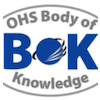Chapter 22.2: Vibration
Abstract
Vibration and noise are closely linked in that both originate from a vibrating body and both have similar physics as they are transmitted as waves through a medium. In contrast to occupational noise, there is to date no regulation for vibration hazards in Australian workplaces and these hazards are not well recognized. The health impacts of vibration can be significant and career limiting. Controlling the effects of vibration relies mainly on elimination and engineering measures. This chapter discusses the concept of vibration, its associated hazards and the effects on individuals. It provides a basic understanding of the health impacts of vibration, measurement of vibration, general controls and concludes with an examination of the role of the generalist OHS professional in the management of vibration hazards.
Keywords: Hand-arm vibration, whole-body, control
First year of publication: 2012
Current Version : 2024
Chapter 22.2: Vibration
Table of contents
| 1 | Introduction |
| 1.1 | Definitions |
| 2 | Historical Context |
| 3 | Extent of the problem |
| 4 | Understanding vibration |
| 4.1 | Nature of vibration |
| 4.2 | Health effects of whole body vibration |
| 4.3 | Health effects of hand-arm vibration |
| 5 | Measurement and evaluation of risk associated with vibration |
| 5.1 | Vibration standards |
| 5.2 | National Policy |
| 6 | Legislation |
| 7 | Control of vibration hazards |
| 8 | Implications for OHS practice |
| 9 | Summary |
| Key thinkers | |
| References |
Purchase the AUDIO chapter here through AIHS
OR

Beno Groothoff MHlthSc, GDipOHS, DipMechEng, FAIOH, COH, MAAS,
Managing Director, Environmental Directions Pty Ltd
Beno has over 50 years’ experience in the fields of occupational hygiene and health and environmental control, gained both in the Netherlands and in Australia. In Brisbane he has worked in private practice, worked with the Environmental Protection Agency followed by 22 years with Workplace Health and Safety Queensland. As Managing Director of Environmental Directions Pty Ltd he provided occupational hygiene services and has written and presented workshops and two-day training courses on noise for many organisations, including Brüel & Kjær in Sydney and New Zealand, the Australian Institute of Occupational Hygiene (AIOH), and the New Zealand Occupational Hygiene Society (NZOHS). He was the course coordinator at the Queensland University of Technology (QUT) Occupational Hygiene and Toxicology course, updating and presenting lectures to post graduate and masters’ students. As Managing Director of his current business, Noise and Vibration Services, he lectures in occupational noise and vibration management to post graduate and masters’ students in the Occupational Hygiene course at the University of Queensland. He is a member of the AV-001 Committee of Standards Australia on occupational noise and vibration.
Peer reviewers
Jane Whitelaw MAppSci (Env Health), FAIOH, COH
Lecturer, Postgraduate OHS Program, University of Wollongong
Marion Burgess MSc(Acoustics), FAAS
Research Officer, Acoustics and Vibration Unit, University of NSW, Canberra
Gary Foster BSc(Chem), MSc(Acoustics), COH,
FAIOH Managing Director, Foster OHS Pty Ltd
Learning outcomes for Vibration
The OHS Body of Knowledge takes a conceptual approach which enables it to be applied in different contexts and frameworks. To optimise its value for education and professional development learning outcomes have been developed for each technical chapter in the Body of Knowledge.
The learning outcomes as described give an indication of what should be the capabilities of a new graduate OHS professional in the workplace. I t is up to those developing OHS education programs, OHS professionals planning their CPD or recruiters or employers selecting or developing people for the OHS function to consider the required breadth vs. depth
Podcast
Webinar
Published 2012 Chapter 22.2 Noise and Vibrations
Published 2019 Chapter 22.2 Vibrations

